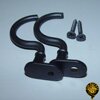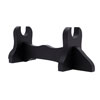|
|
|
 |
|
| Hanwei Practical PRO Katana (SH2162) |
Points: 20

|
Due to demand, the Practical Pro Katana (SH2162) has an extended tsuka and a thicker and longer blade. The blades are constructed from hand-forged, high-carbon steel and are differentially tempered using a traditional claying method. The Practical Pro has a fine polish to it compared to others in the series. The tsuka is wrapped with synthetic black leather for its gripping characteristics and is double-pegged for safety. The saya is done in a deep black lacquer with a black Japanese cotton sageo. The fittings (koshirae) are done in antiqued black iron. The katana is stylized with a round Kuruma tsuba, which represents the "Wheel of Dharma", symbolizing the Buddhist concept of the Noble Eightfold Path. For those interested in an economical katana that can stand the rigors of heavy cutting (tameshigiri), the Practical Pro is an excellent choice.
Antiqued Fittings
Hand-Forged High Carbon Steel Blade
Deep Black Lacquered Saya
|
|
|
|
|
|
 |
|
| Hanwei Bamboo Stick Katana (SH1002) |
Points: 24

|
In 1876, the Samurai were banned from carrying their swords. This attempt to end a thousand year tradition was not received well by the proud warrior class and the stick katana was born. Innocuous walking canes now concealed the revered blades, but the katana lived on. The Bamboo Stick Katana (SH1002) combines an artfully curved bamboo scabbard and handle with a blade (nagasa) that is constructed of hand-forged 1065 high-carbon steel and is differentially tempered using a traditional claying method. The edge hardness and resilient blade body produced by this technique embody the true secret of the Samurai sword.
Hand forged and tempered blade
Hand carved
Genuine temper line
|
|
|
|
|
|
 |
|
| Hanwei Golden Oriole Katana (SH1018) |
Points: 35

|
The deeply lacquered blue of the saya is repeated in the Japanese cotton tsuka-ito, and a mantis motif appears again on the kashira. Unmistakably of Hanwei quality, the sword's approx. 36 cm long tsuka provides a superb balance, allowing it to move very quickly and very freely. Every Katana comes with a custom-fit cloth bag for proper protection and a Japanese blade maintenance kit.
|
|
|
|
|
|
 |
|
| Hanwei Great Wave - Tsunami Katana (SH5004) |
Points: 40

|
Each piece in the Great wave Series (SH5004, SH5002, & SH5022) is stylized with the renowned Tomoe motif. The tsuba, fuchi, & kashira are made of black iron and marked with the Tomoe crest (mon). The blades are hand-forged from T10 high-carbon steel and are differentially tempered using traditional claying methods. The temper line (hamon) is evident and prominent. Each piece has a deeply lacquered black saya with a one-piece brass habaki construction. Real ray skin (same) is used on the tsuka, and the tsuka-ito and sageo are made of premium woven Japanese black cotton. The katana and wakizashi are constructed with a large o-kissaki and are ideal for cutting exercises (tameshigiri). The handle on the tanto is an attractive ribbed buffalo horn.
High-carbon steel
Deeply lacquered black saya
Ideal for cutting exercises
|
|
|
|
|
|
 |
|
| Hanwei Three Monkey Katana (SH2329) |
Points: 40

|
The "Three Wise Monkeys" is a popular symbol of the "See no evil, hear no evil, speak no evil" proverb popular in many cultures around the world. The proverb itself is thought to have originated in China and was brought to Japan by a Buddhist monk, while the association with three monkeys appears to be a Japanese play on words. Our Three Monkey Katana (SH2329) and Wakizashi (SH2330) are built on traditional Shinogi Zukuri style blades with Bo-Hi to reduce weight and improve balance. The high-carbon blade is hand forged and differentially hardened. The blackened iron Tsuba features the "Three Wise Monkeys" in relief.
|
|
|
|
|
|
 |
|
| Hanwei Bushido Katana (SH1210) |
Points: 50

|
Each piece in the Bushido Series (SH1210, SH1211, & SH1212) has a hand-forged & folded K120C powder steel blade, differentially tempered using a traditional claying method to produce an HRC60 edge, HRC40 back. The temper line (hamon) is evident and prominent and the grain pattern (hada) shows distinct layers. The saya are deeply lacquered in gold with inlaid brass cherry blossom (sakura) flowers. High quality ray skin (same) is used on the tsuka of the katana and wakizashi, while the tsuka of the tanto is a gold-plated brass with a battle-scene decoration in relief. The tsuba of the katana and wakizashi is of blackened and bronzed iron, with detailing in gold and silver and a battle scene decoration. The tsuka-ito on the katana and wakizashi and the sageo on all three pieces are woven from premium Japanese cotton. The fuchi and kashira are of blackened bronze with brass detailing, and the kojiri, koiguchi and kurikata are of polished buffalo horn. The blade collar (habaki) is a one-piece brass construction. The katana and wakizashi blades are un-grooved, while the tanto blade is grooved (bo-hi) on both sides. The katana and wakizashi have medium-length (chu) kissaki. See Models SH1211 and SH1212 for the Wakizashi and Tanto details.
Hand forged and folded steel blade
High quality
Traditional construction
|
|
|
|
|
|
 |
|
| Hanwei Bamboo Mat Katana (SH2438) |
Points: 30

|
Our Bamboo Mat Katana features a chu-kissaki blade of Hanwei's own high-alloy HWS-2S steel, which combines impressive performance with a striking O-choji hamon.
|
|
|
|
|
|
 |
|
| Honshu Single Sword Display Stand (UC3194) |
Points: 2

|
Display your swords in style with the Honshu Single Sword Wooden Stand! Thanks to its durable wooden construction and large dimensions, this elegant stand can support almost any knife or sword. The stand is painted matte black.
|
|
|
|
|
|
 |
|
| Black Laquered Single Katana Stand (OH2105) |
Points: 4
|
Our Katana Stand is built to display a single katana to great effect. The padded shelf allows the additional display of a tanto or a maintenance kit. The rich black lacquer finish will enhance the display of any of our Hanwei Katana.
Black Laquered Oak
High quality
Accessory shelf for Tanto or maintenance kit
|
|
|
|
|
|
 |
|
| Hanwei Hanger Black Finish (OH2377) |
Points: 1
|
Our steel sword hangers provide an economical and sturdy solution for displaying any Japanese-style or medieval sword on a wall. Supplied in pairs in either nickel plated (0H2378) or black powder-coated (OH2377)finish, the hangers can be arranged to display the sword either horizontally or at an angle and are supplied with mounting screws (wall-board or sheet-rock mounting will also require wall anchors). Both styles have plastic-covered hooks, to avoid damage to Saya finishes. Simple and unobtrusive, these hangers are designed to focus attention on the piece being displayed.
|
|
|
|
|
|
|
|
Tags:
swords, sword, katana, wakizashi, tanto, japanese sword, medieval sword, viking sword, japanese swords, medieval swords, viking swords, knife, knives, saber, armour, movie swords, movie replicas, martial arts, sporting goods, sporting equipment,
|












